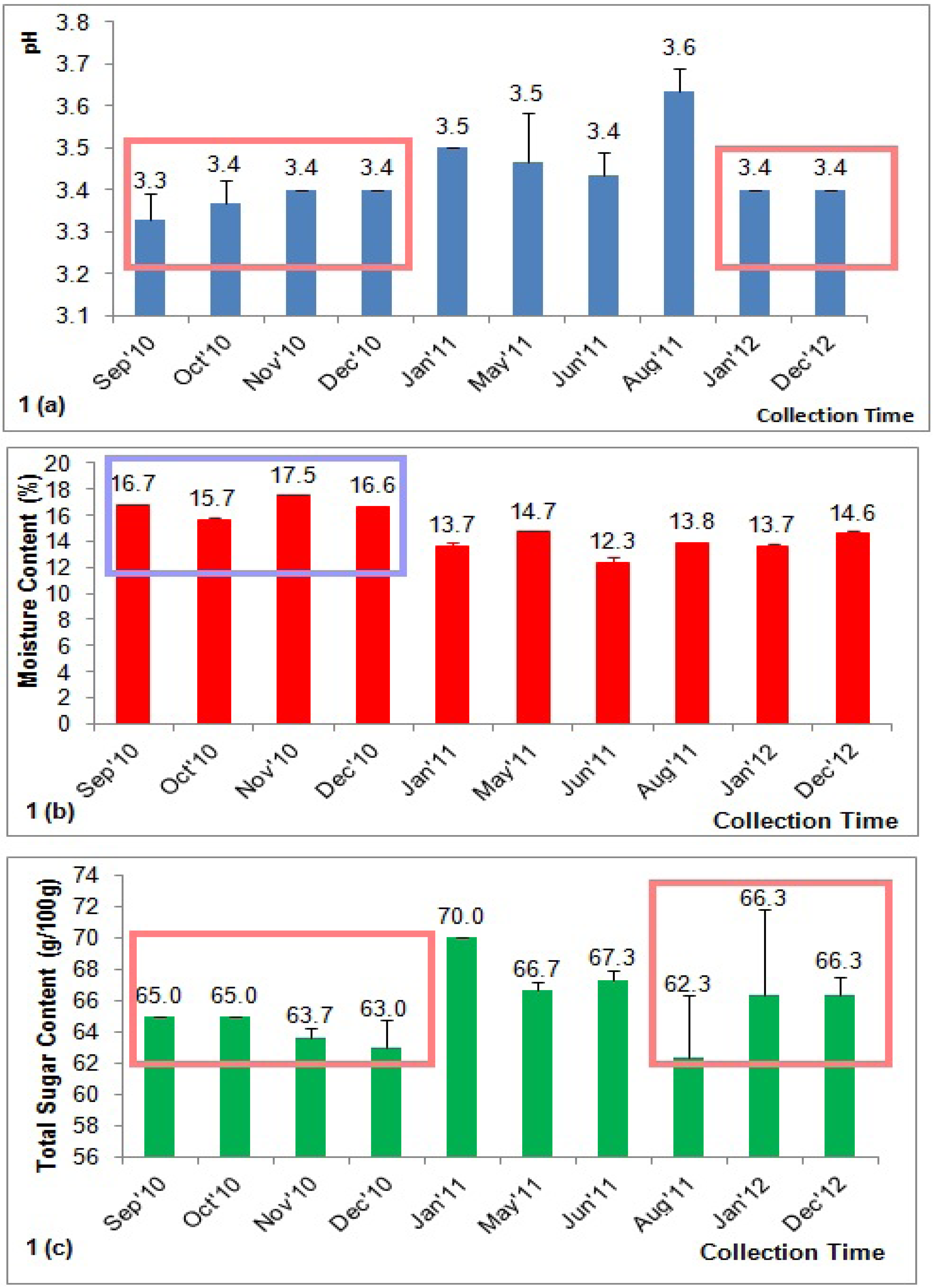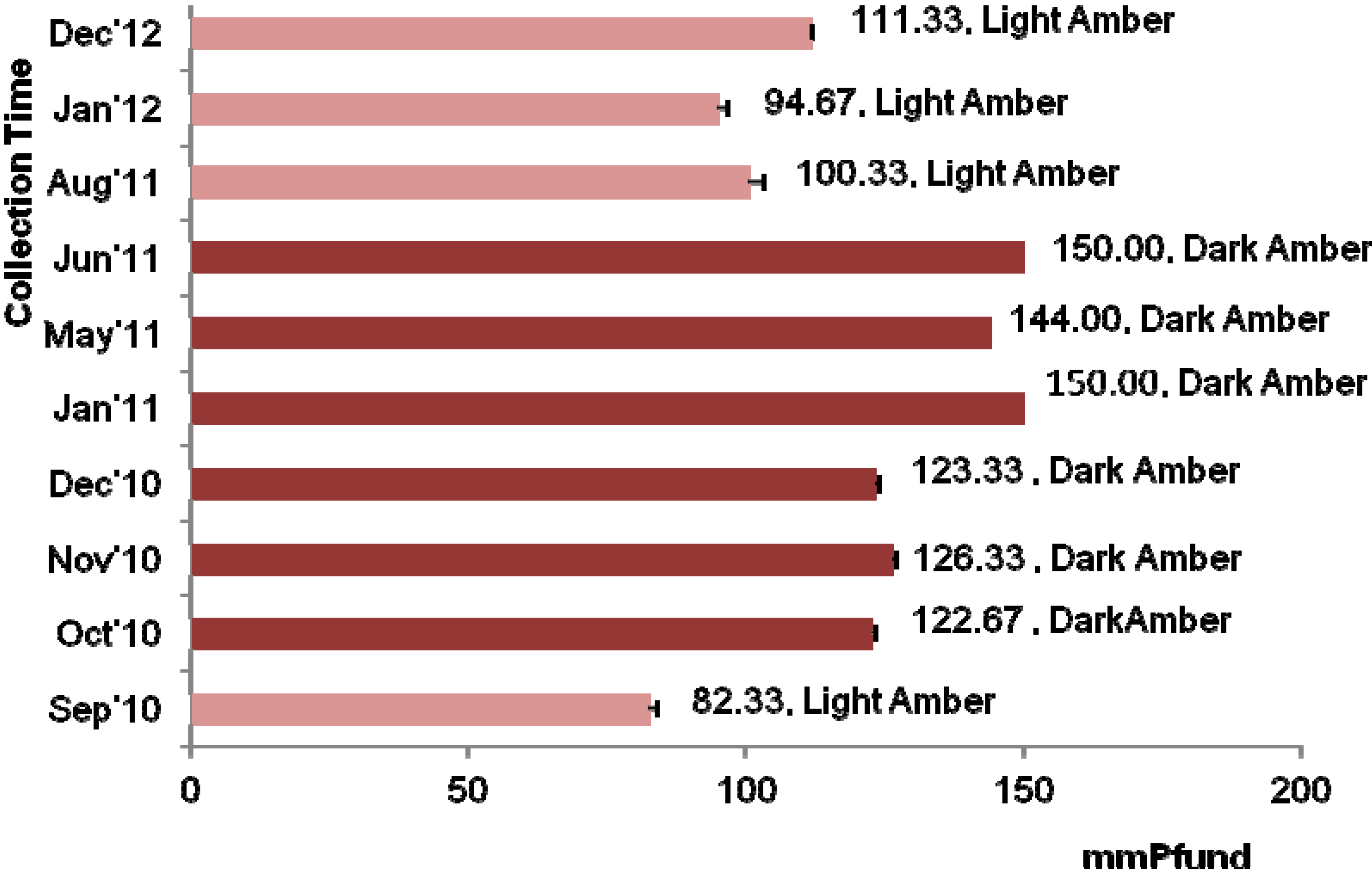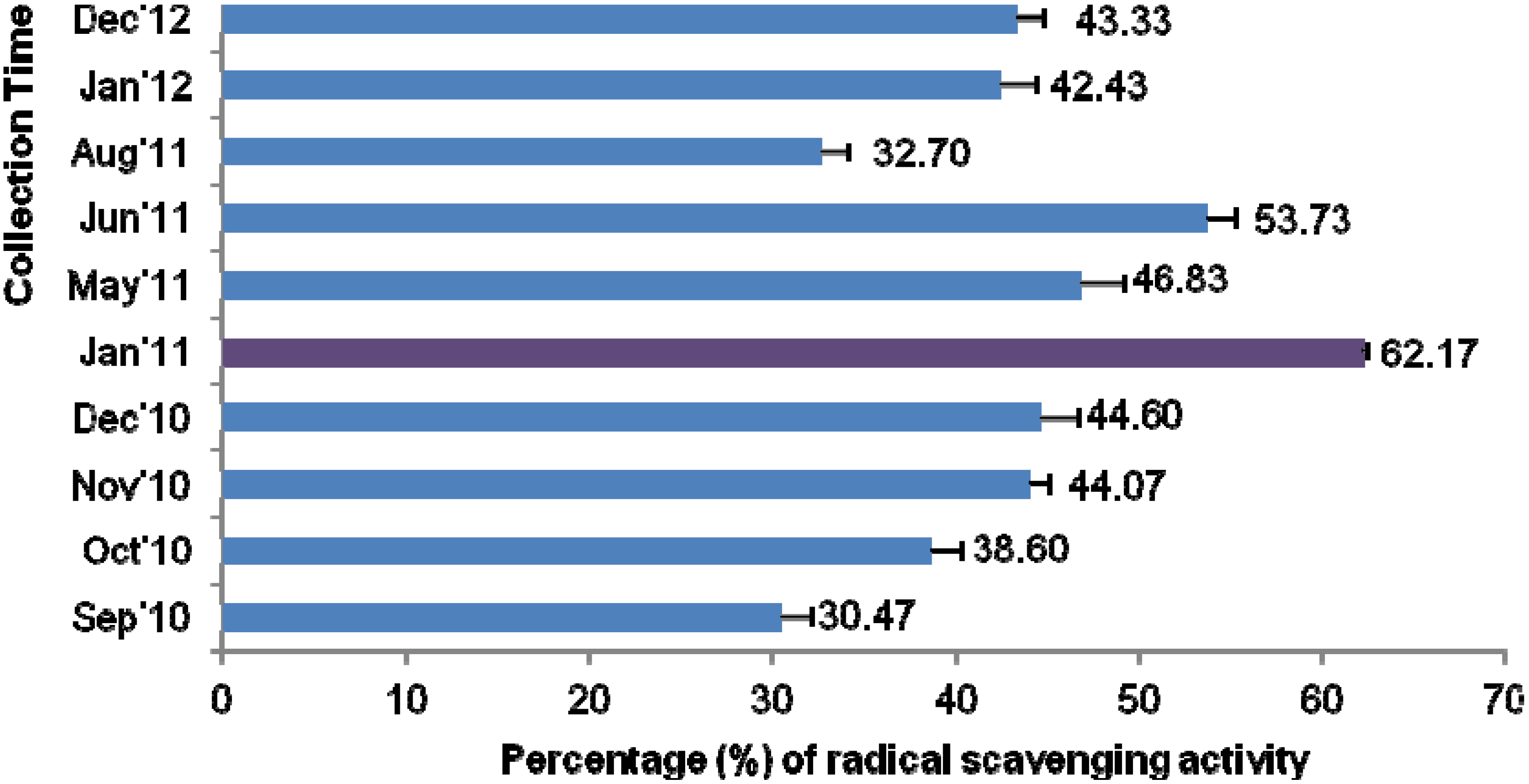Two-Year Variations of Phenolics, Flavonoids and Antioxidant Contents in Acacia Honey
Abstract
:1. Introduction
2. Results and Discussion
2.1. pH
2.2. Moisture Content

2.3. Total Sugar Content
2.4. Color Characteristics

2.5. Color Intensity

2.6. Total Phenolic Content

2.7. Total Flavonoid Content
2.8. DPPH Free Radical-Scavenging Activity

2.9. Determination of Total Antioxidant Content by FRAP Assay

2.10. Proline Content
2.11. Correlation
| Phenolics | Flavonoids | DPPH | FRAP | ABS450 | |
|---|---|---|---|---|---|
| Phenolics | 1.000 | 0.872 ** | 0.785 ** | 0.780 ** | 0.816 ** |
| Flavonoids | 0.872 ** | 1.000 | 0.840 ** | 0.595 * | 0.842 ** |
| DPPH | 0.785 ** | 0.840 ** | 1.000 | 0.850 ** | 0.820 ** |
| FRAP | 0.780 ** | 0.595 * | 0.850 ** | 1.000 | 0.557 * |
| ABS450 | 0.816 ** | 0.842 ** | 0.820 ** | 0.557 * | 1.000 |
3. Experimental
3.1. Honey Samples
| Type of Honey | Sample ID | Time of Collection |
|---|---|---|
| Acacia Batch 1 | AH-1 | September 2010 |
| Acacia Batch 2 | AH-2 | October 2010 |
| Acacia Batch 3 | AH-3 | November 2010 |
| Acacia Batch 4 | AH-4 | December 2010 |
| Acacia Batch 5 | AH-5 | January 2011 |
| Acacia Batch 6 | AH-6 | May 2011 |
| Acacia Batch 7 | AH-7 | June 2011 |
| Acacia Batch 8 | AH-8 | August 2011 |
| Acacia Batch 9 | AH-9 | January 2012 |
| Acacia Batch 10 | AH-10 | December 2012 |
3.2. Chemicals and Reagents
3.3. Physical Analysis
3.3.1. pH
3.3.2. Moisture Content
3.3.3. Total Sugar Content
3.3.4. Honey Color Analysis
3.3.5. Color Intensity (ABS450)
3.4. Analysis of Antioxidant Properties
3.4.1. Determination of Total Phenolic Compounds
3.4.2. Determination of Total Flavonoid Content
3.4.3. DPPH Free Radical-Scavenging Activity
3.4.4. Ferric Reducing/Antioxidant Power Assay (FRAP Assay)
3.4.5. Proline Content
3.5. Statistical Analyses
4. Conclusions
Acknowledgments
Conflicts of Interest
References and Notes
- Gheldof, N.; Engeseth, N.J. Antioxidant capacity of honeys from various floral sources based on the determination of oxygen radical absorbance capacity and inhibition of in vitro lipoprotein oxidation in human serum samples. J. Agric. Food Chem. 2002, 50, 3050–3055. [Google Scholar]
- Ferreira, I.C.F.R.; Aires, E.; Barreira, J.C.M.; Estevinho, L.M. Antioxidant activity of portuguese honey samples: Different contributions of the entire honey and phenolic extract. Food Chem. 2009, 114, 1438–1443. [Google Scholar] [CrossRef]
- Aljadi, A.M.; Kamaruddin, M.Y. Evaluation of the phenolic contents and antioxidant capacities of two malaysian floral honeys. Food Chem. 2004, 85, 513–518. [Google Scholar] [CrossRef]
- Al-Mamary, M.; Al-Meeri, A.; Al-Habori, M. Antioxidant activities and total phenolics of different types of honey. Nutr. Res. 2002, 22, 1041–1047. [Google Scholar] [CrossRef]
- Beretta, G.; Granata, P.; Ferrero, M.; Orioli, M.; Maffei Facino, R. Standardization of antioxidant properties of honey by a combination of spectrophotometric/fluorimetric assays and chemometrics. Anal. Chim. Acta 2005, 533, 185–191. [Google Scholar] [CrossRef]
- Moniruzzaman, M.; Khalil, M.I.; Sulaiman, S.A.; Gan, S.H. Physicochemical and antioxidant properties of malaysian honeys produced by apis cerana, Apis dorsata and apis mellifera. BMC Complement. Altern. Med. 2013, 13, 43. [Google Scholar] [CrossRef]
- Bertoncelj, J.; Doberonc, U.; Jamnik, M.; Golob, T. Evaluation of the phenolic content, antioxidant activity and colour of slovenian honey. Food Chem. 2007, 105, 822–828. [Google Scholar] [CrossRef]
- Blasa, M.; Candiracci, M.; Accorsi, A.; Piacentini, M.P.; Albertini, M.C.; Piatt, E. Raw millefiorihoney is packed full of antioxidants. Food Chem. 2006, 97, 217–222. [Google Scholar] [CrossRef]
- Gheldof, N.; Wang, X.-H.; Engeseth, N. Identification and quantification of antioxidant components of honeys from various floral sources. J. Agric. Food Chem. 2002, 50, 5870–5877. [Google Scholar] [CrossRef]
- Alvarez-Suarez, J.M.; González-Paramás, A.M.; Santos-Buelga, C.; Battino, M. Antioxidant characterization of native monofloral cuban honeys. J. Agric. Food Chem. 2010, 58, 9817–9824. [Google Scholar] [CrossRef]
- Teixeira, É.W.; Message, D.; Negri, G.; Salatino, A.; Stringheta, P.C. Seasonal variation, Chemical composition and antioxidant activity of brazilian propolis samples. Evid. Based Complement. Alternat. Med. 2010, 7, 307–315. [Google Scholar] [CrossRef]
- Jaafar, M.H.M.; Hamid, K.A.; Anuar, N.; Zohdi, R.M.; Effendi, T.J.B. Physicochemical Properties and Pharmacokinetic Profiles of Selected Malaysian Honey. In Proceedings of the 2012 IEEE Symposium on Business, Engineering and Industrial Applications (ISBEIA), Bandung, Indonesia, 23–26 September 2012; pp. 140–145.
- Williams, E.T.; Jeffrey, J.; Barminas, J.T.; Toma, I. Studies on the effects of the honey of two floral types (ziziphus spp. And acelia spp.) on organism associated with burn wound infections. Afr. J. Pure Appl. Chem. 2009, 3, 98–101. [Google Scholar]
- Marghitas, L.A.; Dezmirean, D.S.; Pocol, C.B.; Ilea, M.; Bobis, O.; Gergen, I. The development of a biochemical profile of acacia honey by identifying biochemical determinants of its quality. Not. Bot. Hort. Agrobot. Cluj. 2010, 38, 84–90. [Google Scholar]
- Stelmakienė, A.; Ramanauskienė, K.; Briedis, V.; Leskauskaitė, D. Examination of rheological and physicochemical characteristics in lithuanian honey. Afr. J. Biotechnol. 2012, 11, 12406–12414. [Google Scholar]
- Kowalski, S.; Łukasiewicz, M.; Berski, W. Applicability of physico-chemical parameters of honey for identification of the botanical origin. Acta Sci. Pol. Technol. Aliment. 2013, 12, 51–59. [Google Scholar]
- Alzahrani, H.A.; Alsabehi, R.; Boukraâ, L.; Abdellah, F.; Bellik, Y.; Bakhotmah, B.A. Antibacterial and antioxidant potency of floral honeys from different botanical and geographical origins. Molecules 2012, 17, 10540–10549. [Google Scholar] [CrossRef]
- Gulfraz, M.; Iftikhar, F.; Raja, S.; Asif, S.; Mehmood, S.; Anwar, Z.; Kaukob, G. Quality assessment and antimicrobial activity of various honey types of pakistan. Afr. J. Biotechnol. 2010, 9, 6902–6909. [Google Scholar]
- Bogdanov, S.; Jurendic, T.; Sieber, R. Honey for nutrition and health: A review. J. Am. Coll. Nutr. 2008, 27, 677–689. [Google Scholar] [CrossRef]
- Bang, L.M.; Buntting, C.; Molan, P. The effect of dilution on the rate of hydrogen peroxide production in honey and its implications for wound healing. J. Altern. Complement. Med. 2003, 9, 267–273. [Google Scholar] [CrossRef]
- Terrab, A.; Gonzále, M.; González, A. Characterisation of moroccan unifloral honeys using multivariate analysis. Eur. Food Res. Technol. 2003, 218, 88–95. [Google Scholar] [CrossRef]
- Council Directive of the European Union. Council directive 2001/110/ec of 20 december 2001 relating to honey. Off. J. Eur. Communities 2002, L10, 47–52. [Google Scholar]
- Agricultural Marketing Service, Fruit and Vegetable Division, Processed Products Branch, U.S. Department of Agriculture (USDA). United States Standards for Grades of Extracted Honey; USDA: Washington, DC, USA, 1985. [Google Scholar]
- Díez, M.J.; Andres, A.C.; Terrab, A. Physicochemical parameters and pollen analysis of moroccan honeydew honeys. Int. J. Food Sci. Technol. 2004, 39, 167–176. [Google Scholar] [CrossRef]
- Frankel, S.; Robinson, G.E.; Berenbaum, M.R. Antioxidant capacity and correlation characteristics of 14 unifloral honeys. J. Apic. Res. 1998, 37, 27–31. [Google Scholar]
- Khalil, M.I.; Mahaneem, M.; Jamalullail, S.M.S.; Alam, N.; Sulaiman, S.A. Evaluation of radical scavenging activity and colour intensity of nine malaysian honeys of different origin. J. ApiProduct ApiMedical Sci. 2011, 3, 4–11. [Google Scholar] [CrossRef]
- Mohamed, M.; Sirajudeen, K.N.S.; Swamy, M.; Yaacob, N.S.; Sulaiman, S.A. Studies on the antioxidant properties of tualang honey of malaysia. Afr. J. Tradit. Complement. Altern. Med. 2010, 7, 59. [Google Scholar]
- Krpan, M.; Marković, K.; ŠariĆ, G.; Skoko, B.; Hruškar, M.; Vahčić, N. Antioxidant activities and total phenolics of acacia honey. Czech J. Food Sci. 2009, 27, 246–247. [Google Scholar]
- Wilczyńska, A. Phenolic content and antioxidant activity of different types of polish honey-a short report. Pol. J. Food Nutr. Sci. 2010, 60, 309–313. [Google Scholar]
- Saric, J.; Want, E.J.; Duthaler, U.; Lewis, M.; Keiser, J.; Shockcor, J.P.; Ross, G.A.; Nicholson, J.K.; Holmes, E.; Tavares, M.F. Systematic evaluation of extraction methods for multiplatform-based metabotyping: Application to the fasciola hepatica metabolome. Anal. Chem. 2012, 84, 6963–6972. [Google Scholar] [CrossRef]
- Al, M.L.; Daniel, D.; Moise, A.; Bobis, O.; Laslo, L.; Bogdanov, S. Physico-chemical and bioactive properties of different floral origin honeys from romania. Food Chem. 2009, 112, 863–867. [Google Scholar] [CrossRef]
- Meda, A.; Lamien, C.E.; Romito, M.; Millogo, J.; Nacoulma, O.G. Determination of the total phenolic, flavonoid and proline contents in burkina fasan honey, as well as their radical scavenging activiity. Food Chem. 2005, 91, 571–577. [Google Scholar] [CrossRef]
- Ni, Q.; Xu, G.; Wang, Z.; Gao, Q.; Wang, S.; Zhang, Y. Seasonal variations of the antioxidant composition in ground bamboo sasa argenteastriatus leaves. Int. J. Mol. Sci. 2012, 13, 2249–2262. [Google Scholar] [CrossRef]
- Khalil, M.I.; Moniruzzaman, M.; Boukraâ, L.L.; Benhanifia, M.; Islam, M.A.; Islam, M.N.; Sulaiman, S.A.; Gan, S.H. Physicochemical and antioxidant properties of algerian honey. Molecules 2012, 17, 11199–11215. [Google Scholar] [CrossRef]
- Saxena, S.; Gautam, S.; Sharma, A. Physical, Biochemical and antioxidant properties of some indian honeys. Food Chem. 2010, 118, 391–397. [Google Scholar] [CrossRef]
- Bergner, K.G.; Hahn, H. Zum phenylalaningehalt von honigen. Z. Ernahrungswiss. 1972, 11, 47–54. [Google Scholar] [CrossRef]
- Ouchemoukh, S.; Louaileche, H.; Schweitzer, P. Physicochemical characteristics and pollen spectrum of some algerian honeys. Food Control 2007, 18, 52–58. [Google Scholar] [CrossRef]
- Association of official Analytical Chemists (AOAC). Official Methods of Analysis, 15th ed.; AOAC: Arlington, VA, USA, 1990. [Google Scholar]
- Singleton, V.L.; Orthofer, R.; Lamuela-Raventos, R.M. Analysis of total phenols and other oxidation substrates and antioxidants by means of folin-ciocalteu reagent. Methods Enzymol. 1999, 299, 152–178. [Google Scholar]
- Jia, Z.; Tang, M.; Wu, J. The determination of flavonoid contents in mulberry and their scavenging effects on superoxide radicals. Food Chem. 1999, 64, 555–559. [Google Scholar] [CrossRef]
- Benzie, I.F.; Strain, J.J. Ferric reducing/antioxidant power assay: Direct measure of total antioxidant activity of biological fluids and modified version for simultaneous measurement of total antioxidant power and ascorbic acid concentration. Methods Enzymol. 1999, 299, 15–27. [Google Scholar]
- Bogdanov, S.; Martin, P.; Lüllmann, C. Harmonised methods of the european honey commission. Apidologie 1997, 28, 1–59. [Google Scholar]
- Sample Availability: Samples of the tested Malaysian acacia honeys are available from the authors.
© 2013 by the authors; licensee MDPI, Basel, Switzerland. This article is an open access article distributed under the terms and conditions of the Creative Commons Attribution license (http://creativecommons.org/licenses/by/3.0/).
Share and Cite
Moniruzzaman, M.; Sulaiman, S.A.; Azlan, S.A.M.; Gan, S.H. Two-Year Variations of Phenolics, Flavonoids and Antioxidant Contents in Acacia Honey. Molecules 2013, 18, 14694-14710. https://doi.org/10.3390/molecules181214694
Moniruzzaman M, Sulaiman SA, Azlan SAM, Gan SH. Two-Year Variations of Phenolics, Flavonoids and Antioxidant Contents in Acacia Honey. Molecules. 2013; 18(12):14694-14710. https://doi.org/10.3390/molecules181214694
Chicago/Turabian StyleMoniruzzaman, Mohammed, Siti Amrah Sulaiman, Siti Amirah Mohd Azlan, and Siew Hua Gan. 2013. "Two-Year Variations of Phenolics, Flavonoids and Antioxidant Contents in Acacia Honey" Molecules 18, no. 12: 14694-14710. https://doi.org/10.3390/molecules181214694
APA StyleMoniruzzaman, M., Sulaiman, S. A., Azlan, S. A. M., & Gan, S. H. (2013). Two-Year Variations of Phenolics, Flavonoids and Antioxidant Contents in Acacia Honey. Molecules, 18(12), 14694-14710. https://doi.org/10.3390/molecules181214694





